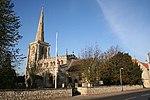RAF Barkston Heath
Airfields of the IX Troop Carrier Command in the United KingdomAirports in EnglandAirports in the East MidlandsArmy Air Corps (United Kingdom)Royal Air Force stations in Lincolnshire ... and 2 more
South Kesteven DistrictUse British English from May 2013

Royal Air Force Barkston Heath or RAF Barkston Heath (ICAO: EGYE) is a Royal Air Force Relief Landing Ground under the command of RAF Cranwell near Grantham, Lincolnshire, England. RAF Barkston Heath has the Naval Element of No. 3 Flying Training School RAF (3 FTS) which, for a period between approximately 1995 and 2010, operated the Slingsby T67M260 Firefly, followed by the Grob Tutor T.1 operated between 2010 and 2018. No. 3 FTS currently provide elementary flying training for Royal Navy students on the Grob Prefect T.1. A secondary role of RAF Barkston Heath is as a Relief Landing Ground for the flying training activities at RAF Cranwell.
Excerpt from the Wikipedia article RAF Barkston Heath (License: CC BY-SA 3.0, Authors, Images).RAF Barkston Heath
High Dike, South Kesteven Barkston
Geographical coordinates (GPS) Address External links Nearby Places Show on map
Geographical coordinates (GPS)
| Latitude | Longitude |
|---|---|
| N 52.962222222222 ° | E -0.56166666666667 ° |
Address
RAF Barkston Heath
High Dike
NG31 9ER South Kesteven, Barkston
England, United Kingdom
Open on Google Maps









